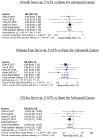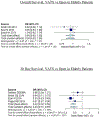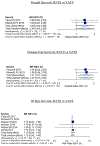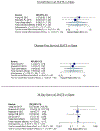Comparative Effectiveness of Surgical Approaches for Lung Cancer
- PMID: 33309173
- PMCID: PMC8169528
- DOI: 10.1016/j.jss.2020.10.020
Comparative Effectiveness of Surgical Approaches for Lung Cancer
Abstract
Background: The magnitude of association and quality of evidence comparing surgical approaches for lung cancer resection has not been analyzed. This has resulted in conflicting information regarding the relative superiority of the different approaches and disparate opinions on the optimal surgical treatment. We reviewed and systematically analyzed all published data comparing near- (30-d) and long-term mortality for minimally invasive to open surgical approaches for lung cancer.
Methods: Comprehensive search of EMBASE, MEDLINE, and the Cochrane Library, from January 2009 to August 2019, was performed to identify the studies and those that passed bias assessment were included in the analysis utilizing propensity score matching techniques. Meta-analysis was performed using random-effects and fixed-effects models. Risk of bias was assessed via the Newcastle-Ottawa Scale and the ROBINS-I tool. The study was registered in PROSPERO (CRD42020150923) prior to analysis.
Results: Overall, 1382 publications were identified but 19 studies were included encompassing 47,054 patients after matching. Minimally invasive techniques were found to be superior with respect to near-term mortality in early and advanced-stage lung cancer (risk ratio 0.45, 95% confidence interval [CI] 0.21-0.95, I2 = 0%) as well as for elderly patients (odds ratio 0.45, 95% CI 0.31-0.65, I2 = 30%), but did not demonstrate benefit for high-risk patients (odds ratio 0.74, 95% CI 0.06-8.73, I2 = 78%). However, no difference was found in long-term survival.
Conclusions: We performed the first systematic review and meta-analysis to compare surgical approaches for lung cancer which indicated that minimally invasive techniques may be superior to thoracotomy in near-term mortality, but there is no difference in long-term outcomes.
Keywords: Lung cancer; Meta-analysis; Non-small cell lung cancer (NSCLC); Randomized controlled trials (RCTs); Retrospective observational studies; Robot-assisted thoracoscopic surgery (RATS); Video-assisted thoracoscopic surgery (VATS).
Copyright © 2020 Elsevier Inc. All rights reserved.
Figures





References
-
- American Cancer Society. Cancer Facts & Figures 2019. Atlanta: American Cancer Society; 2019 2019.
-
- Boffa DJ, Kosinski AS, Furnary AP, et al. Minimally Invasive Lung Cancer Surgery Performed by Thoracic Surgeons as Effective as Thoracotomy. Journal of Clinical Oncology. 2018;36(23):2378-+. - PubMed
-
- Yang CJ, Kumar A, Klapper JA, et al. A National Analysis of Long-term Survival Following Thoracoscopic Versus Open Lobectomy for Stage I Non-small-cell Lung Cancer. Ann Surg. 2019;269(1):163–171. - PubMed
Publication types
MeSH terms
Grants and funding
LinkOut - more resources
Full Text Sources
Other Literature Sources
Medical

